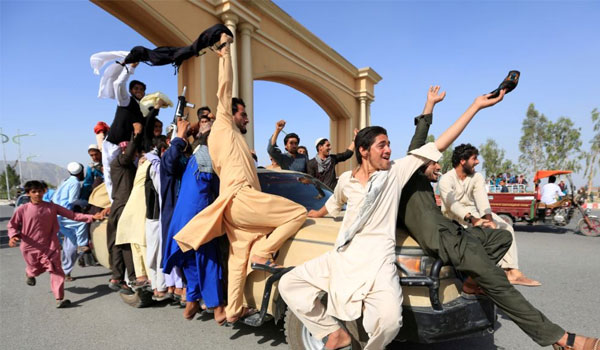Expectations and optimism for long-lasting peace rose to unprecedented heights when Government of Afghanistan and Taliban insurgents reached agreement to observe three days ceasefire during last three days Eid festivities across the country.
Peace prevailed throughout the country during three days Eid, minus three incidents of suicide bombings in Nangarhar and Logar provinces, which were claimed by Daesh, and the victims included Afghan security forces and Taliban fighters who were jointly controlling checkpoints at the gates of the city.
Taliban fighters poured in to cities throughout Afghanistan and enjoyed Eid festivities with people and Government officials, and the same was true for Government officials and those individuals who could not otherwise visit areas under Taliban control, managed to sneak in to their villages and enjoy Eid festivities with their family members and friends, who had been separated for years. The air was full of joy for ordinary people – both at cities and villages.
But immediately after the clock ticked past 12am mid-night, Taliban insurgents retreated back to their villages and Government officials rushed back to cities to avoid persecution. Not long passed, fighting erupted sporadically across the country and continued to till date, taking lives of more than two thousands five hundred ordinary civilians, including children, women and men, Government security personnel and Taliban fighters. Recurrent and continuation of this unholy war - after a joyful ceasefire - washed away all expectations and optimism for possibility of permanent peace.
While negotiations with Taliban insurgents for peace continues its course involving countries with high stakes in the process, including the United States of America, Government of Afghanistan, Pakistan, China, Russia, Saudi Arabia and UAE throughout this time since the cessation of ceasefire, Government of Afghanistan contemplates yet another ceasefire with Taliban insurgents for upcoming Eid festivities, which according to 2018 calendar, will start beginning 21 or 22 August this year. Any peace deal – be it long term or short term – should follow comparatively less violent period before it is implemented. Unofficial and unconfirmed figures, mentioned in the paragraph above, obtained from media outlets draw a grim picture of casualties inflicted on ordinary people, and on the families of security personnel and those of Taliban fighters. This state of affairs exhibit no tangible events and logical signs that should precede peace before it takes hold. The three days peace that prevailed last time was unprecedented and was welcomed by all quarters in Afghanistan.
It only increased optimism and expectations for permanent peace in the country. To say it in other words, the success of last time three days peace was very much founded in cooperation and acceptance by the people of Afghanistan across the country. However, it will be very hard to instill the same sort of optimism and expectations in people’s minds and hearts to welcome any short-term peace deal, without first laying out extensive, agreed foundations among warring factions for a long term, permanent peace. Because of resilient nature of insurgent fighters and absence of any guarantee for a long-term peace, it is not sensible and logical to embark on short-sighted and unproductive attempts to bring peace.
The risks of such actions might have many unknown fallouts, which can even include skirmishes and attempts to vengeance by Government security personnel and Taliban fighters when they mix together because the wounds inflicted on these individuals for losses of lives of their family members and / or closed relatives and friends would still be fresh. Therefore, it is incumbent on Government of Afghanistan to take into consideration all possibilities before embarking on any peace deals with Taliban insurgents. As was put forth by Mr. Upendra Baghel, an expert in building state institutions, ‘…Ceasefire does not mean to reduce deployment, but to increase them without combat function’. Therefore, it is highly advisable for Government of Afghanistan to keep military machinery strong in defense of the motherland.
One major set-back to go ahead with the ceasefire last time, and reasons for Government to once again engage in fighting with Taliban insurgents were that Taliban insurgents continued to talk from a position of strength, which had resulted in their stubbornness, insistence to fight, and higher demands during peace negotiations. Unfortunately, the rush by US Government to engage US diplomats directly with Taliban insurgents to talk peace has come exactly at times when Taliban claimed supremacy over Afghan Government in the field.
This was what Taliban insurgents demanded right from the beginning. Exclusion of Afghanistan Government in peace negotiations with Taliban insurgents has only strengthened the will of the insurgents to insist on their demands – whatever they might be – and in case these demands are not met, they can easily resort to violence.
This is what has been encouraged by actions of the United States Government to rush to bring about so called peace without first laying out necessary ground work in place, which are mainly based on urges and policies at home to end this so called ‘longest US war on foreign lands’. It is very important for the US Government and other international alliance, in support of stabilizing Afghanistan, to understand that a lot of blood has been shed, huge amount of resources have been expended to bring about the present progress in Afghanistan.
Taliban insurgents are under pressure from Pakistan for taking certain decisions, including the misplaced belief by Taliban so called leadership that they have had upper hand in ongoing war, hence they insisted to fight. These and so many other factors and undercurrents should be guarded against during ongoing peace negotiations.
Home » Opinion » Short-Term Ceasefires & Their Effects on Long-Term Peace
Short-Term Ceasefires & Their Effects on Long-Term Peace
|

